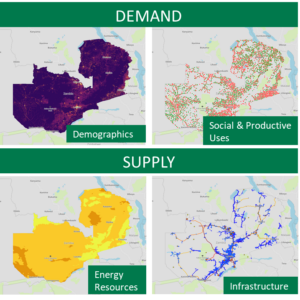Written by Pauline Githugu, Team Leader ACE TAF
As far as universal access to clean energy is concerned, there is no doubt that firstly, there remains a huge number of households in Sub-Sahara Africa that do not have access to clean energy. As of 2018 the number stood at 548 million unelectrified people.[1] This has been compounded by the effects of COVID-19 pandemic globally. It is estimated that between 26-39 million people are projected to fall into extreme poverty in the region.[2] Secondly, whereas the expansion of grid electrification is the most desired form of clean energy, governments will not achieve universal access to clean energy through grid connections by 2030. Thirdly, the cost of connecting the grid to most of these households would not be economical as the households’ demand for energy and willingness to pay is demonstrably low[3]. Fourth, the most vulnerable populations that remain off-grid are in far to reach areas which have also not been accessed by off-grid solutions or products due to the remoteness and terrain of their location and the areas being sparsely populated with some of the households also being migratory more so those in the more arid regions. In both grid connected and off-grid areas some households have no access as they have very low incomes or have no means of earning an income due to disabilities, or that they are child-led households or orphans, or displaced populations such as refugees, or widows and aged persons.
Following the COVID-19 pandemic there has been a considerable amount on focus on how to buoy the off-grid companies through the pandemic and rightly so as they need to remain operational to serve millions of customers who are currently using their products and accessing their services. The GIZ Energy Access Industry Barometer[4] indicates that the situation is dire for many off-grid companies with some of the smaller ones likely to close in the next 6 months.
While much of the attention has been on the off-grid companies, the consumer surveys currently being conducted by 60Decibels[5] point to the need to also pay attention to consumers. The survey while focusing on the struggle by current consumers to keep their lights on also brings a forgotten voice to the table.
With this backdrop, we are faced with three critical questions – will the industry survive the COVID-19 pandemic, will the customers currently on pay-as-you-go purchase schemes continue to pay for the systems, will those who have not been reached have access to stand alone solar systems by 2030? For those households that have not been reached there is the additional question of how we can ensure that good quality off-grid products can reach these households at an affordable price.
While there are several rallying calls to “leave no one behind” there is definitely no silver bullet to address these important questions. The Africa Clean Energy Technical Assistance Facility (ACE TAF) is seeking to answer these questions through various studies that have been conducted and others which are currently underway.
We have found that there is a case for governments to consider employing public funds to assist current stand-alone customers whose incomes have been impacted by the COVID-19 pandemic in our COVID briefing note[6]. This will essentially help consumers to keep their lights on. There are currently other initiatives by the companies themselves which include extending payment periods.
What about consumers who are yet to be reached? We have explored this in depth with the Demand Side Subsidy which confirms not only the need for the funding of subsidy schemes to reach the most remote households in order to achieve universal access, but also the need to do so urgently if SDG 7 is to be achieved by 2030. The study also proposes different designs for consideration and piloting of these subsidies which are targeted at the more vulnerable segment of consumers. We are also addressing the need to explore other financing alternatives through our study on Alternative Consumer Financing.
Our other studies also point to the need for more efficiency in the operations of the SAS companies so as to bring down the cost of products to the end consumer. Our soon to be released study on the Cost of Products in Landlocked Countries is one such study. In this study we explore if indeed the cost of products in landlocked countries are impacted by the logistics and what does in fact contribute to the pricing of products. ACE TAF has also provided clarity to the sector through the Kenya Importation Handbook[7] and the Nigeria Importation Guide[8] which have led to the smoother importation of SAS products and reduction of costs incurred due to delays. Other cost drivers such as taxation are also being addressed in a study on Responsible Taxation.
In all these studies, we are seeking to provide the answers to the nagging question on how to make SAS products not only affordable but also accessible to households that need them the most.
[1] International Energy Agency (IEA) et al, Tracking SDG 7: The Energy Progress Report 2019 (Washington DC: IEA, IRENA, UNSD, WB, WHO, 2019), 23, https://trackingsdg7.esmap.org/data/files/download-documents/2019-tracking_sdg7-execsumm-withoutembargoed.pdf
[2] World Bank (2020) Updated Estimates of the Impact of COVID-19 on Global Poverty
[3] https://editorialexpress.com/cgi-bin/conference/download.cgi?db_name=CSAE2017&paper_id=878
[4] https://endev.info/content/File:EnDev_Energy_Access_Industry_Barometer_Summary_FINAL.pdf
[5] https://app.60decibels.com/covid-19#explore for Kenya, Nigeria, Rwanda, Sierra Leone, Tanzania, Uganda and Zambia
[6] https://ace-taf.org/kb/covid-19-briefing-urgent-need-for-consumer-relief-to-sustain-energy-access/
[7] https://ace-taf.org/kb/importation-guidelines-for-solar-in-kenya/
[8] https://ace-taf.org/kb/importation-guide-for-solar-pv-products-and-technologies-in-nigeria-2020/










